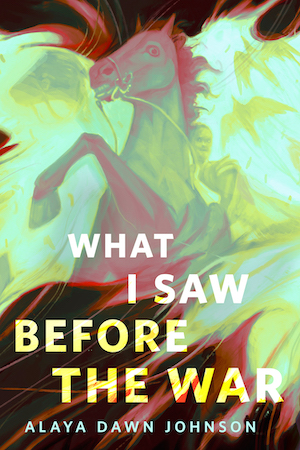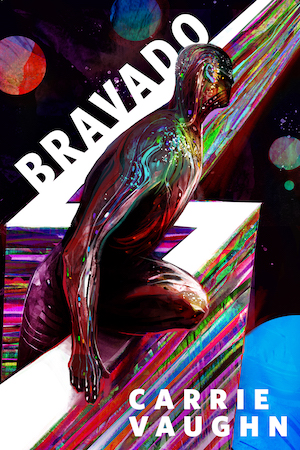My first encounter with William Gibson was neatly printed on the flap of an envelope, a letter from my friend Colin. We had a habit of inscribing epigraphs on our letters to each other—this was 1990, three years before I had my first real email address—and on one letter he copied out the famous opening sentence of Neuromancer, a vivid piece of imagery that digital cable has rendered nearly as quaint as the paper letter it adorned: “The sky above the port was the color of television, tuned to a dead channel.”
I was fifteen and still pretty naive. I don’t think I’d quite realized before that books were written like that. I also tended to take Colin’s prescriptions for what to read as pure gospel, as he’d already steered me toward Grant Morrison’s Doom Patrol and Neil Gaiman’s Sandman, so with my allowance the following week I bought a copy of Neuromancer from the local Waldenbooks. As with many books in those days of copious, under-appreciated free time, I devoured it whole over the next 48 hours, failed to really understand what I’d just read, and then, over several days on a junior-year college-visiting road trip with my father, reread the whole thing. Maybe twice. After that, there was no going back.
In “An Invitation”, his introduction to Jorge Luis Borges’s Labyrinths, William Gibson describes the experience of reading Borges as “installing something that exponentially increased what one day would be called bandwidth”. Read enough of Gibson’s work and you may find that doing so has installed in your brain some kind of new software through which your experience of the intersection of human consciousness and technology is heightened, amplified, granted depth and significance. At fifteen, I understood that intersection solely in terms of (already tired, though I didn’t know it at the time) “chips implanted in the skull”, an idea thoroughly demythologized by Gibson in a 2000 piece for Time Magazine. Years later, I’ve come to understand that the human-technology link-up is something more subtle and more widespread than that, and Gibson’s own evolving writing has been key in that understanding.
William Gibson is one of those writers whose name is in the process of becoming an adjective—consider Kafkaesque, Ballardian, Pynchonesque: words for which the meaning has become osmotically absorbed even by people who haven’t necessarily read the authors’ books. Now we have Gibsonesque (or perhaps “Gibsonian”? The jury remains out). As with all such things, it’s not necessarily easy to define—if it was, we wouldn’t have needed to adjective-ize the name to begin with.
Defining “Gibsonesque” usually involves frequent invocation of words beginning with “cyber-“. Japan may be cited as well, and Gibson himself frequently acknowledges his fascination with the culture that to him, always seems to be a few steps ahead of Europe and America, and which has brought us the Gibsonesque retail wonders that are Muji and Uniqlo. It’s not inaccurate to acknowledge these things, but to focus exclusively on them can be unnecessarily limiting, and also risks imposing a false exoticism on his ideas. The essays gathered in the new collection Distrust That Particular Flavor provide an up-to-date map of William Gibson’s interests and obsessions, a supplement to the territory navigated in his fiction. What the Gibsonesque is not is the “particular flavor” of HG Wells italics of which he declares his distrust in 2006’s “Time Machine Cuba”: “the italics of the perpetually impatient and somehow perpetually unworldly futurist, seeing his model going terminally wrong in the hands of the less clever, the less evolved.” In the Gibsonesque world, science fiction is understood to be not an oracle, but a mirror of the time in which it was written. Technology reserved solely for the elite, high in a glass-and-steel tower. Oft-quoted and sometimes misunderstood is the classic maxim from the novella “Burning Chrome”: “The street finds its own uses for things.”
 But these days, as Gibson would hasten to point out, “the street” isn’t some high-tech hacker enclave in the back streets of a near-future megalopolis. It’s everywhere and includes every one of us—nowadays everyone is a hacker, a coolhunter, a “picker” of rare finds, a console jockey with a MacBook. And the human-technology “cyborg” interface isn’t a robot with a human brain, or vice-versa, as he points out in 2008’s “Googling the Cyborg”: “The physical union of human and machine, long dreaded and long anticipated, has been an accomplished fact for decades, though we tend not to see it.” It’s the “extended nervous system” of broadcast media and the Internet. You read this essay here on Tor.com; perhaps then you’ll go to the website of your book retailer of choice to order an ebook edition to read on your iPad or Kindle or Nook; and later maybe you’ll google Vannevar Bush because Gibson has piqued your interest in him. Meanwhile, whether you acknowledge it or not, all of your actions are being recorded somewhere, in some database or other, and indeed you may be participating in your own surveillance on occasion by way of a smartphone camera and a YouTube account. You, the devices, and these interactions comprise the true cybernetic organism, and you don’t need any hardware in your skull for it. You are that which uses the Internet, something very different from your grandparents or great-grandparents, who may yet be old enough to remember being that which did not even watch television yet.
But these days, as Gibson would hasten to point out, “the street” isn’t some high-tech hacker enclave in the back streets of a near-future megalopolis. It’s everywhere and includes every one of us—nowadays everyone is a hacker, a coolhunter, a “picker” of rare finds, a console jockey with a MacBook. And the human-technology “cyborg” interface isn’t a robot with a human brain, or vice-versa, as he points out in 2008’s “Googling the Cyborg”: “The physical union of human and machine, long dreaded and long anticipated, has been an accomplished fact for decades, though we tend not to see it.” It’s the “extended nervous system” of broadcast media and the Internet. You read this essay here on Tor.com; perhaps then you’ll go to the website of your book retailer of choice to order an ebook edition to read on your iPad or Kindle or Nook; and later maybe you’ll google Vannevar Bush because Gibson has piqued your interest in him. Meanwhile, whether you acknowledge it or not, all of your actions are being recorded somewhere, in some database or other, and indeed you may be participating in your own surveillance on occasion by way of a smartphone camera and a YouTube account. You, the devices, and these interactions comprise the true cybernetic organism, and you don’t need any hardware in your skull for it. You are that which uses the Internet, something very different from your grandparents or great-grandparents, who may yet be old enough to remember being that which did not even watch television yet.
The Gibsonesque is largely, although not exclusively, urban. It can be found in the liminal states induced by travel, in jet lag, and on the threshold between waking and sleeping. It is present in secret brands and hidden displays of wealth and power. It exists in the otaku, and in the practice of highly specialized knowledge and attention to detail, whether it be Japanese schoolchildren forming lustrous balls of mud or the shopper in Tokyu Hands seeking out the perfect German sole enamel to treat her shoes. The Gibsonesque extends into aesthetics, such that Bruce Sterling can jokingly (?) refer to his friend as “noted clothing designer William Gibson“. Back in 2003, I saw a messenger bag described in a women’s sportswear catalogue as having “the feel of something out of a William Gibson novel”. The bag, with its peculiar asymmetrical shape and basketball-textured bottom, did have a vaguely “futuristic” vibe, but in hindsight, it’s clear that it owed much to the mirrorshades-and-black-leather aesthetic of 1980s cyberpunk. The aesthetics of which, to be sure, Gibson had no small part in codifying.
But it’s best not to be limited by potentially dated references, and is instead instructive to read what his characters have to say about the lost American clothing industry in Zero History, or to read the 2003 essay “Skip Spence’s Jeans”, a meditation on the sartorial choices of a musician who Gibson met in California the early 1970s. Musician Skip Spence wore immaculate, perfectly tailored jeans that had been “reconstructed, recontextualized, jacked out of blue denim mundania entirely, into some unknown realm of Hispano-America, deeply Catholic romanticism”. Gibson is acutely aware of the markers and signifiers inherent in clothing—which is quite not the same as being interested in fashion, although fashion does enter into it. There is a desire to be entirely free of the mainstream fashion context, and in so doing, create one’s own context anew. Cayce Pollard in Pattern Recognition is described as “a design-free zone, a one-woman school of anti whose very austerity periodically threatens to spawn its own cult.” Gender aside, Gibson is very close to describing himself. The paean to Spence’s jeans suggests as much, not to mention his partnership with Buzz Ricksons (from which you can buy the Cayce Pollard MA-1 flight jacket, in black) and the tendency of his fans to immediately seek out whatever pen or wallet manufacturer he mentions in an interview or on Twitter.
(Here is where I admit that I have a Buzz Ricksons M-65 field jacket signed by the man himself, a Caran d’Ache ballpoint pen that he mentioned in an interview once, and a Porter wallet co-branded with Buzz Ricksons’ William Gibson line. The immediate and sustained reaction of my husband to the minimalist, part-Kevlar shirt that Gibson wore at a signing in Austin was to identify (Arc’teryx Veilance) and acquire one of those shirts. I know of what I speak, believe me.)
You could thus be misled into thinking that the Gibsonesque is centered largely on things, material acquisitions. But consider what those things embody and signify: minimalism, atemporality, non-disposability. The Gibsonesque is at once an embrace of the transformative, consciousness-extending nature of technology and a shield against the permanent case of future-shock that is the twenty-first century condition. It is also cool, but it’s a different kind of cool than the sort that was so seductive to a fifteen-year-old, eager to imagine oneself as a cowboy hacker or as a street-fighter with razorblade fingernails. That future-vision remains compelling, but the world has moved on. It may not look like we thought it would, but the science-fiction future, the new Oceania, the Sprawl, really is where we live now, and we may thank William Gibson for giving us a means by which to understand it.
Karin Kross also maintains The Gibsonian Institute, an intermittently-updated William Gibson fan tumblr. She lives and writes in Austin, Texas with her husband Bruce (with whom she first bonded over a shared love for William Gibson’s books) and their cat Muji (yes, named after the store). She can be found elsewhere on Tumblr and Twitter.









